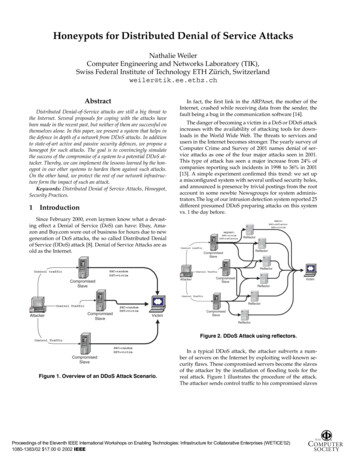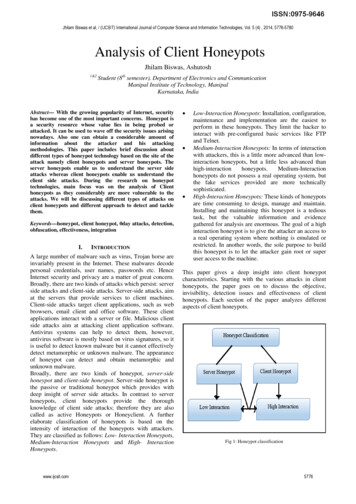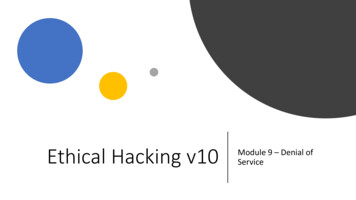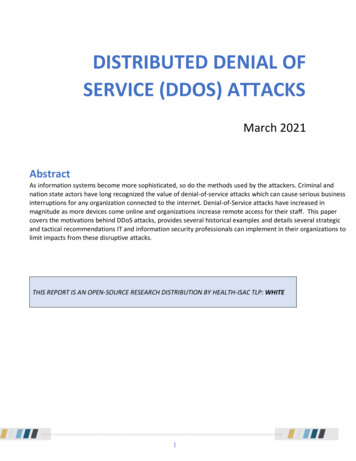
Transcription
Honeypots for Distributed Denial of Service AttacksNathalie WeilerComputer Engineering and Networks Laboratory (TIK),Swiss Federal Institute of Technology ETH Zürich, d Denial-of-Service attacks are still a big threat tothe Internet. Several proposals for coping with the attacks havebeen made in the recent past, but neither of them are successful onthemselves alone. In this paper, we present a system that helps inthe defence in depth of a network from DDoS attacks. In additionto state-of-art active and passive security defences, we propose ahoneypot for such attacks. The goal is to convincingly simulatethe success of the compromise of a system to a potential DDoS attacker. Thereby, we can implement the lessons learned by the honeypot in our other systems to harden them against such attacks.On the other hand, we protect the rest of our network infrastructure form the impact of such an attack.Keywords: Distributed Denial of Service Attacks, Honeypot,Security Practices.1 IntroductionSince February 2000, even laymen know what a devasting effect a Denial of Service (DoS) can have: Ebay, Amazon and Buy.com were out of business for hours due to newgeneration of DoS attacks, the so called Distributed Denialof Service (DDoS) attack [8]. Denial of Service Attacks are asold as the Internet.In fact, the first link in the ARPAnet, the mother of theInternet, crashed while receiving data from the sender, thefault being a bug in the communication software [14].The danger of becoming a victim in a DoS or DDoS attackincreases with the availability of attacking tools for downloads in the World Wide Web. The threats to services andusers in the Internet becomes stronger. The yearly survey ofComputer Crime and Survey of 2001 names denial of service attacks as one of the four major attacks seen in 2001.This type of attack has seen a major increase from 24% ofcompanies reporting such incidents in 1998 to 36% in 2001[13]. A simple experiment confirmed this trend: we set upa misconfigured system with several unfixed security holes,and announced is presence by trivial postings from the rootaccount in some newbie Newsgroups for system administrators.The log of our intrusion detection system reported 25different presumed DDoS preparing attacks on this systemvs. 1 the day before.REPLY:SRC reflectorDST victimREQUEST:SRC victimDST reflectorReflectorControl trafficReflectorCompromisedSlaveReflectorSRC randomDST victimControl trafficControl timReflectorControl TrafficReflectorControl TrafficAttackerCompromisedSlaveSRC randomDST victimVictimCompromisedSlaveReflectorFigure 2. DDoS Attack using reflectors.Control TrafficSRC randomDST victimCompromisedSlaveFigure 1. Overview of an DDoS Attack Scenario.In a typical DDoS attack, the attacker subverts a number of servers on the Internet by exploiting well-known security flaws. These compromised servers become the slavesof the attacker by the installation of flooding tools for thereal attack. Figure 1 illustrates the procedure of the attack.The attacker sends control traffic to his compromised slavesProceedings of the Eleventh IEEE International Workshops on Enabling Technologies: Infrastructure for Collaborative Enterprises (WETICE’02)1080-1383/02 17.00 2002 IEEE
that instructs them to generate high volume traffic towardthe victim, typically with a faked source address to preventbacktracing to the slaves (that might be used in another attack).In this paper, we present the design of a system that allows to disrupt the attacker’s chain. The goal of the systemis to convince the attacker that he successfully compromisedthe slave. In reality, the system is a kind of a honeypot thatlures him to believe so. Thereby, the operator of the honeypot learns the tactics of the attacker and can implement efficient defences in the rest of his network. On the other hand,the attack on the victim is of course successfully inhibitedand the recording of the compromise may help in a legal action against the attacker.The remaining of the paper is organised as follows: First,Section 2 characterises DDoS attacks. Actual methods of defences are discussed in Section 3. Section 4 details the designof our system. We conclude with a short evaluation and further work in Section 5.2 Characteristics of Distributed Denial ofService Attacks2.1 Definitions of DoS and DDoSA denial of service (DoS) attack is commonly characterised as an incident in which a user or organisation is deprived of the services of a resource they would normally expect to have. Typically, the loss of service is the inability ofa particular network service, such as e-mail, to be availableor the temporary loss of all network connectivity and services. In the worst case, for example, a Web site accessed bymillions of people can occasionally be forced to temporarilycease operation. A denial of service attack can also destroyprogramming and files in a computer system [3, 2].This attack works well if the attacker and the target areequally well equipped in bandwidth and in computing resources. Distributed DoS are used in order to magnify theeffect on the victim. Thereby, the attacker can for instancesuccessfully flood a high-end web server consisting of acluster of web servers served by a powerful load balancer.The WWW Security FAQ identifies such attacks as one ofthe most dangerous because of their impact on web servers.[19] defines: A Distributed Denial of Service (DDoS) attackuses many computers to launch a coordinated DoS attackagainst one or more targets. Using client/server technology,the perpetrator is able to multiply the effectiveness of theDenial of Service significantly by harnessing the resourcesof multiple unwitting accomplice computers which serve asattack platforms. Typically a DDoS master program is installed on one computer using a stolen account. The masterprogram, at a designated time, then communicates to anynumber of ”agent” programs, installed on computers anywhere on the Internet. The agents, when they receive thecommand, initiate the attack. Using client/server technology, the master program can initiate hundreds or even thousands of agent programs within seconds.A further improvement on the impact of the attack isachieved by using a second type of intermediate systemcalled a reflector [12]. The usage of such reflectors is illustrated in Figure 2: The compromised servers send spoofedrequests to the reflectors. The reflectors then reply to theseen source of the request: the victim of the DDoS attack2.2 CharacterisationBoth types of attacks have in common that they typicallyuse a limited number of well know attacks sometimes in different combinations. A DoS attack’s main characteristics isthat an attacker attempts to prevent one or more legitimateusers of a service from the use of the required resources.Therefore, he attempts (1) to inhibit legitimate network traffic by flooding the network with useless traffic. (2) to denyaccess to a service by disrupting connections between twoparties, (3) to block the access of a particular individual to aservice, or (4) to disrupt the specific system or service itself.DDoS attacks follow the same path, but they becomemore effective and difficult to prevent because of the intermediary systems that add a many-to-one dimension to thewhole attack. In the following we will explain by examplesthe different characteristics of common DoS and DDoS attacks.Software bugs are frequently used by attackers to compromise a system. One of the first seen DoS attacks, whilenot widely spread, relied on a software bug in the IOS/700software release version 4.1. It allowed to crash some Cisco7xx routers by connecting with telnet and typing very longpassword strings. By exploiting this software bug, attackerscould reboot the 7xx routers and deny service to legitimateusers during the reboot period [5].Another example of a well exploited software bug is the“myriad escaped characters vulnerability” in the MicrosoftInternet Information Server1 . [11] defines it as a denial ofservice vulnerability allowing a malicious user to overloada web server by a request for a file via a specially-malformedURL for some period of time. The vulnerability does notcause the server to fail, or cause any data to be lost, and theserver eventually would resume normal operation, givenenough time. Microsoft’s IIS implements the decoding of escaped characters2 in URL strings very inefficiently. So that’swhy the server was overloaded with the processing of longstrings with a large number of escaped characters. Microsoftdoes of course provide a patch for this vulnerability on itstechnical support web page.A Smurf DoS uses the Internet Control Message Protocol (ICMP) that handles errors and exchange control messages [10]. It sends an ICMP ECHO REQUEST packet witha spoofed source address (the IP address of the victim) toone or several subnet broadcast addresses. All machines onthe subnet reply directly to the victim’s address. The normal effect this attack causes is congestion either in the victim’s network connection or in the access ISP network. The1Better known as the URL parsing bug.characters are way for users to specify non-printingor special characters in URLs. For example, if a percent sign is followed by two hexadecimal digits, they are replaced by the equivalent ASCII character.2 EscapedProceedings of the Eleventh IEEE International Workshops on Enabling Technologies: Infrastructure for Collaborative Enterprises (WETICE’02)1080-1383/02 17.00 2002 IEEE
most effective countermeasure against this attack is to disable broadcast pings from outside a subnet. Many peoplebelieve that a subnet that still allows such pings have afaulty configuration. Therefore, Smurf like attacks belong tothe class of attacks based on misconfigurations.Another popular attack misuses the standard three-wayhandshake of the Transport Control Protocol (TCP) [4]. Thishandshake requires an exchange of three messages betweenclient and server before the service can be used: (1) Theclient indicates that it wants to start a connection with theserver by sending a synchronise (SYN) request. (2) Theserver replies with a message indicating its readiness: aSYN/ACK (ACKnowledgment) reply. (3) The connectioncan be used after the final ACK of the client. The so calledSYN flood attacks the server – the victim in this case – bysending a large amount of SYN requests without fulfillingthe third step of the handshake. Typically, the client’s address is also spoofed. Because today’s TCP/IP implementations only handle a limited number of connections, theserver will discard new connections as long as its backlog queue is full with semi-open connections. This attack isan example of a protocol attack. Analogue attacks exist forother network protocols such as UDP and ICMP.Setting up of a stolen accountas a repository for attack toolsScanning of large ranges forpotential vulnerable targetsCreation of script to perform theexploit and to report the resultsChoice of a subset of suitablecompromised servers from thelistScript automated installation ofthe needed tools on thecompromised serversOptional installation of a root kitto hide the compromiseFigure 3. DDoS Pattern.DDoS attacks follow the simple pattern illustrated inFigure 3. We list the variations on this pattern in chronological order on an example basis.Trinoo was the first widely known DDoS tool. It usesTCP to exchange control data between the attacker and themaster attack host. The compromised slaves are controlledthough UDP messages. These then operate an UDP floodingattack on the victim.Tribe Flood Network (TFN) uses command line interfaces (telnet or ssh) to deliver the control messages to theslaves. Communication between the slave and the attackdaemon is done by ICMP echo reply packets because thesetypically pass through firewalls and are harder to detectthan UDP packets. In addition to Trinoo’s UDP flooding attack, TFN supports TCP SYN and ICMP floods as well asSmurf attacks.Stacheldraht is a variant of TFN that uses encrypted TCPconnections for control traffic. Furthermore, attack daemonsmay be updated automatically.TFN2K further enhances TFN: communications are encrypted to make it more difficult to detect the attack. Slavesand attack daemons communicate through ICMP, UDP orTCP selected randomly. .3 Defenses against AttacksSeveral proposals have been made to cope with DDoSattacks even though neither of them solves the issue completely. Broadly the approaches can be categorised into twobroad categories: mitigation of the impact/detection theattack and identification of the source of the attack. Thefirst category includes measures as (a) filtering packets [6],(b) disabling broadcasts and unused services, and (c) applying security patches [7]. The second area of proposalsfocuses on identifying the source of the DDoS attack. Thisproblem of tracing back of such packets of data receivedconsiderable attention in the past: Bellovin’s ITRACE [1]uses ICMP packets to verify the path of a small subset ofselected forwarded packets. So, the victim may be able tolocate the compromised slave. [15] use a packet markingscheme to enable the victim to traceback the real source ofthe packet. [18] enhance the scheme by reducing the numberof markings by employing network topology maps. Finally,[16] propose a source path isolation engine in strategical located routers in order to enable victims to request the takenpath of a given packet. However, all these mechanisms suppose that a large enough amount of networks implementsthem. How realistic this assumption is for the future cannotbe fully answered currently.4 A Honeypot for DDoSIn our analysis of existing research in the coping withDDoS, we looked for a generally applicable solution. Theresponse to an incident should be independent of platformas the attack occurs across many different platforms withina network and should not assume the changes in a largepart of the backbone network. Therefore, we propose a system that can be generally applied in each organisation andrelies on state-of-the-art technology. The vantages of thissystem are two-fold: First we can defend our operationalnetwork with a high probability against known DDoS andagainst new, future variants. Second, we trap the attacker sothat recording of the compromise can help in a legal actionagainst the attacker.The devised system is a honeypot that lures the attackerto believe that he successfully compromised a slave for hisneeds. In reality, the honeypot learns the tools, tactics, andProceedings of the Eleventh IEEE International Workshops on Enabling Technologies: Infrastructure for Collaborative Enterprises (WETICE’02)1080-1383/02 17.00 2002 IEEE
DMZPenetrationTestingSecure WebServersWeb ServerCA/PKIPolicyDeploymentDNS Server FTP ServerSecurityAppliancesVulnerability Active ContentMonitoringEnterprise SecurityAdministrationMail ServerIncident ResponseNetwork IDSHost- ability ted OS(a) Implementation in the Organisation.DMZSecure WebServersWeb Server(HONEYPOT)CA/PKIInternetFTP Server(HONEYPOT)Vulnerability llFirewallActive ContentMonitoringAttackerMail Server(HONEYPOT)DNS AN(b) View of the Attacker.Figure 4. Two Different Views of the Honeypot.Proceedings of the Eleventh IEEE International Workshops on Enabling Technologies: Infrastructure for Collaborative Enterprises (WETICE’02)1080-1383/02 17.00 2002 IEEE
motives of the blackhat. The lessons learned are then implemented in the rest of the network as defensive mechanisms.The honeypot provides an organisation information ontheir own security risks and vulnerabilities. It should consistof similar systems and applications than the one used by theorganisation for its productive environment so to give theattacker a real world feeling and to be able to implement thelearned lessons in the productive environment.Figure 4(a) illustrates the implementation in the organisation. The depicted organisation runs a well set up andmaintained security infrastructure with classical elementsand recent developments: Services such as web, mail, ftpservices and DNS that should be accessible form the outside are situated in a demilitarised zone (DMZ). The localinternal network (LAN) of the organisation is in anotherzone protected by a firewall with adequate, up-to-date security appliances; even inside the LAN file transmissionare always encrypted, the clients run trusted operating systems, the services are managed by a indirect authentication method3 . Furthermore, detection systems are running:host based intrusion detection systems (IDS) and vulnerability scanners ,and network IDS together with network vulnerability scanners at the borders of the organisation’s network. The organisation might operate virtual private networks (VPN) with local subsidiaries and a public key infrastructure (PKI) for intra-business corporation. Standardmechanisms are used for protection of web and mail servers.In this security infrastructure, we introduce a new system: a honeypot that should attract distributed denialof-service attackers. This virtual system physically corresponds to a set of computing system or a network of suchsystems following the idea of the Honeynet project4 [9]. TheHoneynet is a conceptually upgrading of traditional honeypots used for intrusion detection. According to the definition,”a Honeynet is different from traditional honeypots, it iswhat we would categorise as a research honeypot. This doesnot make it a better solution then traditional honeypots,merely it has a different purpose. Instead of its value beingdetecting or deceiving attackers, its value is gaining information on threats. The two biggest design differences froma classic honeypot are: (1) It is not a single system but a network of multiple systems. (2) All systems placed within theHoneynet are standard production systems. These are realsystems and applications, the same you find on the Internet. Nothing is emulated nor is anything done to make thesystems less secure. The risks and vulnerabilities discoveredwithin a Honeynet are the same that exist in many organisations today. ”Our DDoS honeypot must fulfil the task to lure the attacker into employing this system as a compromised slave.3 Kerberos is an example of such a method. An off-line authentication method (i.e. based on certificates) should be used if the management of the clients becomes too burdening and if the organisation requires larger corporation environments than one single LAN.4 The Honeynet itself cannot be directly applied to this situation, because it does not deceive the attacker about the real network structure. However our DDoS honeypot needs this illusionas shown below.That’s why the attacker’s packet – regardless of protocol –should be handled by the honeypot while all other – regular– packets are forwarded to the legitimate destination (webserver, mail server, client, e.g.). So, the honeypot should simulate the whole network of the organisation to the attackeras shown in Figure 4(b). Every system in the organisationmight be a honeypot. For example, if the attacker’s compromise packets to the webserver of the corporation are detected, the packets go to the honeypot for processing. Thereply the attacker gets should be indistinguishable from areal reply of the web server.Three major problems must be solved to successfullyproject this illusion to the attacker:1. The attack must be detectable.2. The attack packets must be actively directed to the honeypot.3. The honeypot must be able to simulate the organisation’snetwork infrastructure, at least the parts known to theattacker.The first issue is linked to the solution of the second problem: both should ideally be implemented by a transparentpacket forwarder at the border of the corporation’s DMZ.Its functionality is to look at each packet and decide if thepacket belongs to a DDoS attack. If the test is negative, thepacket should go to the given destination inside the DMZor the LAN. In all other cases the packet forwarder shoulddetermine which part of the honeypot system should produce the request. A possible setup of the honeypot could bethat each Internet service of the corporation is replicated inone system of the honeypot. First experiments showed thatthe forwarder is a potential bottleneck in this setup. Therefore, we investigate currently different other setups withnext generation routers for this issue.The detection itself is done by efficiently matching signatures of DDoS packets. Currently, we employ similar signatures as the DDoS signatures of [17], to be able to detectknow attacks with a large probability. However, this methodhas the drawback, although being very efficient,that new attacks are not detected until our system knows the signature.Finally, the third problem can be solved by employing avariant of the Honeynet approach. Then, it should also beeasier to simulate realistic confirmation messages to the attacker as depicted in Figure 5. The depicted warning systemof the honeypots to the reflectors and the victim enables toplay down eventual probes of the attacker to verify the success of the DDoS attack at these points.5 ConclusionIn this paper, we described a promising tool for luringattackers into the belief of a successful DDoS attack. Weshowed how such a system can be used in a defence indepth real-world network environment. We identified different problems with the current realisation and providedfirst solutions to cope with the scalability of the honeypot.Although our honeypot is still in its’ infancy, we achievedfirst promising results with the presented initial setup. Future work will consist of the development of a honeynetProceedings of the Eleventh IEEE International Workshops on Enabling Technologies: Infrastructure for Collaborative Enterprises (WETICE’02)1080-1383/02 17.00 2002 IEEE
Simulated Traffic, e.g. fakeconfirmation messages tothe attackerInformation of Reflectorsand victim about detectedattack patternReflectorControl rControl TrafficAttackerControl TrafficCompromisedSlaveSimulated Traffic, e.g. fakeconfirmation messages tothe ONEYPOT)ReflectorFigure 5. Tracing of the Attacker.scalable to a middle sized organisation and the investigationof other solution to the re-direction of packets.References[1] S. Bellovin.ICMP Traceback Messages.www.research.att.com/ smb/papers/draft-bellovin-itrace-00.txt, March 2000.http:[2] CERT Cordination Center.CA-1999-17: Denial-ofService l.[3] CERT Cordination Center. CA-2000-01: advisories/CA-2000-01.html.[4] CERT Cordination Center. CA-2000-21: Denial-of-Service Vulnerabilities in TCP/IP Stacks. http://www.cert.org/advisories/CA-2000-21.html.[5] Cisco Systems, Inc. Cisco Security Advisory: 7xx Router Password Buffer Overflow. ml, June 1998.[6] Cisco Systems, Inc. Defining Strategies to Protect against TCPSYN Denial of Service Attacks. http://www.cisco.com/warp/public/707/4.html, July 1999.[7] P. Ferguson and D. Senie. Network Ingress Filtering: DefeatingDenial-of-service Attacks which Employ IP Source AddressSpoofing. RFC 2267, January 1998.[8] A. Harrison.The Denial-of-service Attack 2/14/dos.aftermath.idg, 2000.[9] HoneyNet Project. http://project.honeynet.org/.[10] C. A. Huegen. The latest in Denial-of-Service Attacks: ”Smurfing” Description and Information to Minimize Effects. WhitePaper, February 2000.[11] Microsoft Technical Support. Myriad Escaped echnet/security/bulletin/fq00-023.asp, April 2000.[12] V. Paxson. An Analysis of Using Reflectors for DistributedDenial-of-Service Attacks. Computer Communication Review,31(3), July 2001.[13] R. Power. 2001 CSI/FBI Computer Crime and Security Survey.Technical report, Computer Security Institute, 2001.[14] P. H. Salus. Cating the Net: From ARPANET to INTERNET andBeyond. Addison-Wesley, 1995.[15] S. Savage, D. Wetherall, A. Karlin, and T. Anderson. Practical Network Support for IP Traceback. In Proceedings of ACMSIGCOMM 2000, August 2000.[16] A. Snoeren, C. Partridge, L. Sanchez, W. Strayer, C. Jones, andF. Tchakountio. Hash-Based IP Traceback. In Proceedings ofACM SIGCOMM 2001, August 2001.[17] Snort Signature Database.snort-db.http://www.snort.org/[18] D. Song and A. Perrig. Advanced and Authenticated MarkingSchemes for IP Traceback. In Proceedings of ACM INFOCOM2001, April 2001.[19] L. D. Stein and J. N. Stewart. The World Wide Web Security FAQ – Version 3.1.2. http://www.w3.org/Security/Faq/, February 2002.Proceedings of the Eleventh IEEE International Workshops on Enabling Technologies: Infrastructure for Collaborative Enterprises (WETICE’02)1080-1383/02 17.00 2002 IEEE
2 Characteristics of Distributed Denial of Service Attacks 2.1 Definitions of DoS and DDoS A denial of service (DoS) attack is commonly charac-terised as an incident in which a user or organisation is de-prived of the services of a resource they would normally ex-pect to have. Typically, the loss of service is the inability of










